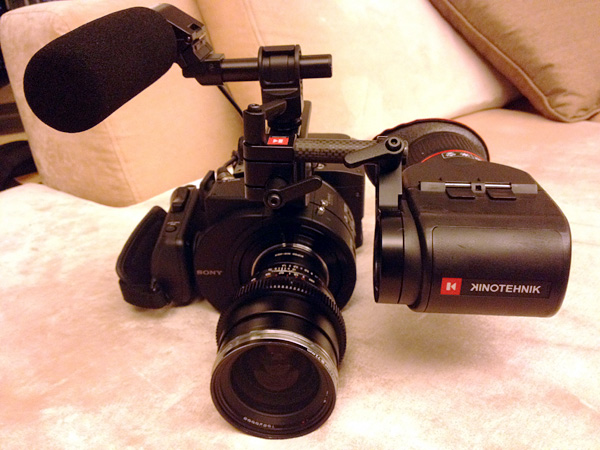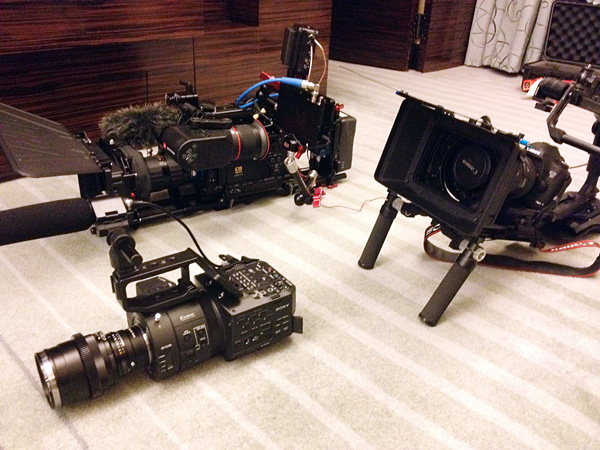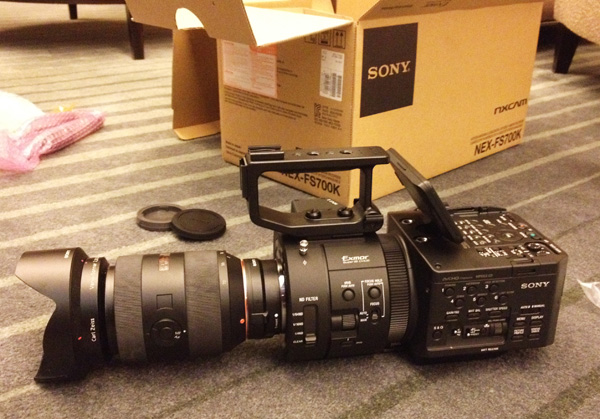By technical editor Matt Allard:
I received my production model Sony NEX FS700 this week and was very keen to test out its low light capabilities. Before all the critics start and I get bombarded with emails asking why I did this and why I didn’t do that, please let me state that what I did here is not a very scientific test. I did it solely to see how the three cameras I own look and compare to each other. The big thing to remember is all these cameras can be made to look great if the operator knows what he or she is doing. I purposely set up the test to make the cameras look as bad as possible when comparing ISO. What I tried to do is keep the background quite dark without pushing the blacks below 0%. It is in the dark colours like blues and grays as well as the blacks where noise shows up. I wore a black t-shirt so it could help you see how the different cameras handled various ISO settings.
I’m currently on assignment and working very long hours so I did this test very late at night and in my own time. I apologize that I couldn’t find a better looking model for these tests. It may not all be in focus as I was having to shoot myself.
The cameras are not really matched to each other. I used a similar white balance on each camera ( F3 S-Log was set at 3200k). The same Zeiss 50mm f1.4 lens was used on both the Sony FS700 and F3, and a Zeiss 85mm f1.4 on the 5D mkIII as it is full frame and not Super35. Both lenses were left wide open at f1.4. The exact same lighting was used for all the cameras and ISO settings. I wanted to keep the lighting identical so there would be no variables. Nothing was exposed correctly and that was my aim. The FS700 was recorded to an SD card in AVCHD at 24Mb/s. The F3 non S-Log was recorded at 35Mb/s to an SXS card. The F3 S-Log was recorded at 220Mb/s Prores on an Atomos Samurai. The 5D mkIII was set to ALL-I H.264 recording to a SD card.

From my observations the FS700 struggled the most out the 3 cameras. It tended to produce the most noise. I think once you start going over about 1600 ISO you have to watch out for noise that may start to appear in your footage that could cause it to be unusable. Honestly speaking it all depends on what you are shooting and what you are shooting for. In a news environment you could very easily get away with using the FS700 camera at 6400 ISO and even 10000ISO if you had to.
The 5D mkIII tends to crush the blacks quite a lot and I’d speculate that Canon techs do this to help try and hide image noise. In truth I’m sure it has to do more with how the camera is designed. At the end of the day the 5D mkIII is a DSLR and is designed as a stills camera. The 5D mkIII is very good in low light and certainly handles the noise better than the FS700. Even at 3200 ISO the 5D mkIII is pretty good. I found around 5000 ISO to be about the limit I would use on this camera. Over this it does start to produce that ugly DSLR noise. Again your project and what your shooting will ultimately dictate what ISO you comfortable to push the camera to.
The Sony F3 performed very well. It deals with noise the best out of the three cameras. Even all the way up to its limit of 6400 ISO it shows the least amount of noise in dark areas of the picture. Using the optional S-log gives you even more amazing sensitivity with only a very small increase in noise over non S-log, it’s hard to see. It does produce a very pleasing film grain noise when using S-log too.
I also tested the FS700 with high speed frame rates at a few different ISO settings. It does seem to me that the camera produces a lot more noise when running faster frame rates. I would personally try to shoot all your high speed material at no more than ISO 800. At 1600 it tends to produce quite a bit of image noise. Again I’m shooting these tests in conditions that don’t flatter the cameras so I’m sure in better lighting conditions they may fare better.
I do think that in controlled situations 200fps looks really really nice on the FS700. Even 400fps can look pretty good in the right conditions. Over 400fps and it basically becomes unusable. The picture is extremely noisy at 800fps. If your just producing stuff for the web or standard definition distribution you might just get away with it. At 800/900fps it also crops the sensor so your framing will change – just a point to remember. Let’s face it the FS700 is a $8000 camera and the fact it can even do 900fps is pretty amazing.
I have only had the FS700 for a few days so I am yet to completely put it through its paces. I did not get time to check it with an external Prores recorder. I did check it with a using a HDMI EVF. What I found was that the HDMI output only outputs the timecode to the EVF when the output of information is enabled. This is a bit of pain as i would like to see all the information on my external EVF.
My overall initial thoughts are that the FS700 is indeed a very nice camera. The image quality is fantastic and the footage looks great. I still find the button layout and the design of the camera quite strange. It is however very light and offers a wide range of features. High speed frame rates, built in ND filters, SDI out and future 4K recording capability are extraordinary for the price. I will do a full review at a later date when I find the time.
About Matthew Allard, Aljazeera Senior Field Cameraman, Kuala Lumpur:
Matt has been a Camera/Editor in TV news for more 20 years, previously working for both Channel 9 and Channel 10 in Australia. Twice Network Ten Australia’s cameraman of the year as well as being a Walkley Finalist for outstanding camerawork in 2006 (for coverage of the Cronulla Race Riots) and a Logie Finalist for outstanding news coverage 2006 (Bali 9). He is a multiple ACS (Australian Cinematographers Society) award winner. His Sword Maker story that was shot on a 7D won the prestigious Neil Davis International News Golden Tripod at the 2011 ACS Awards. He has covered news events in more than 35 countries, from major sporting events to terrorist bombings. Based out of the Kuala Lumpur broadcast centre in Malaysia he is an avid user and follower of new technology, shooting stories on HD broadcast cameras, the Sony F3 as well as new Canon DSLRs.








